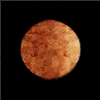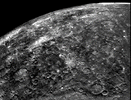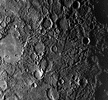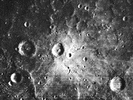
 Mercury
Mercury

Planet Profile
Mass (kg)............................................3.3 x 10^23
Diameter (km)........................................4878
Mean density (kg/m^3) ...............................5420
Escape velocity (m/sec)..............................4300
Average distance from Sun (AU).......................0.387
Rotation period (length of day) (in Earth days)......58.65
Revolution period (length of year) (in Earth days)...87.97
Obliquity (tilt of axis) (degrees)...................0
Orbit inclination (degrees)..........................7
Orbit eccentricity...................................0.206
Mean surface temperature (K).........................452
Maximum surface temperature (K)......................700
Minimum surface temperature (K)......................100
Visual geometric albedo..............................0.12
Largest known surface feature........................Caloris Basin
(1350 km diameter)
Atmospheric components...............................trace amounts of
hydrogen and
helium
Surface materials....................................basaltic and
anorthositic rocks
and regolith

 Mosaic of Mercury
Mosaic of Mercury
This photomosaic of the planet Mercury was assembled from individual
high-resolution images taken by Mariner 10 shortly before closest
approach in 1974. The sun is shining from the right, and the terminator
is at about 100 degrees west longitude. Crater Kuiper, named after
astronomer Gerard P. Kuiper, can be seen just below the center of the
planet's illuminated side. The landscape is dominated by large craters
and basins with extensive plains between craters.
 Caloris Basin
Caloris Basin
Seen here is part of the enormous Caloris Basin, which is thought to be
similar to the large circular basins found on the moon. Probably formed
by a giant impact early in Mercury's history, this basin was
subsequently filled by lava flows. The nature of the wrinkle ridges on
its floor is arguable: some scientists claim tectonics while others
suggest they are due to volcanic flows escaping from fractures.
 Southwest Mercury
Southwest Mercury
The southwest quadrant of Mercury is seen in this image taken March 29,
1974, by the Mariner 10 spacecraft. The picture was taken four hours
before the time of closest approach when Mariner was 198,000 km
(122,760 mi) from the planet. The largest craters seen in this picture
are about 100 km (62 mi) in diameter.
 Hills of Mercury
Hills of Mercury
"Weird terrain" best describes this hilly, lineated region of
Mercury. Scientists note that this area is at the antipodal point to
the large Caloris basin. The shock wave produced by the Caloris impact
may have been reflected and focused to the antipodal point, thus
jumbling the crust and breaking it into a series of complex blocks. The
area covered is about 800 km (497 mi) on a side.
 Mercury Close Up
Mercury Close Up
The small, bright halo crater (center) is 10 km (6 mi) in diameter.
The prominent crater further left, which has a central peak, is 30 km
(19 mi) across. The darker, lightly cratered area (upper left) may be
an ancient lava flow. Mercury's surface is similar to that of Earth's
moon, where a history of heavy cratering is followed by volcanic
filling.

 Welcome to the Planets Home Page
Welcome to the Planets Home Page


 Mercury
Mercury

 Mosaic of Mercury
Mosaic of Mercury  Caloris Basin
Caloris Basin  Southwest Mercury
Southwest Mercury  Hills of Mercury
Hills of Mercury  Mercury Close Up
Mercury Close Up 